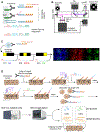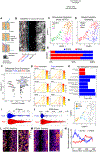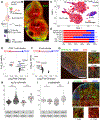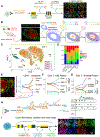ZipSeq: barcoding for real-time mapping of single cell transcriptomes
- PMID: 32632238
- PMCID: PMC7891292
- DOI: 10.1038/s41592-020-0880-2
ZipSeq: barcoding for real-time mapping of single cell transcriptomes
Abstract
Spatial transcriptomics seeks to integrate single cell transcriptomic data within the three-dimensional space of multicellular biology. Current methods to correlate a cell's position with its transcriptome in living tissues have various limitations. We developed an approach, called 'ZipSeq', that uses patterned illumination and photocaged oligonucleotides to serially print barcodes ('zipcodes') onto live cells in intact tissues, in real time and with an on-the-fly selection of patterns. Using ZipSeq, we mapped gene expression in three settings: in vitro wound healing, live lymph node sections and a live tumor microenvironment. In all cases, we discovered new gene expression patterns associated with histological structures. In the tumor microenvironment, this demonstrated a trajectory of myeloid and T cell differentiation from the periphery inward. A combinatorial variation of ZipSeq efficiently scales in the number of regions defined, providing a pathway for complete mapping of live tissues, subsequent to real-time imaging or perturbation.
Conflict of interest statement
COMPETING FINANCIAL INTERESTS
K.H.H. and M.F.K. are listed on a patent application regarding the ZipSeq approach.
Figures





Comment in
-
A zipcode for transcriptomes.Nat Rev Genet. 2020 Sep;21(9):508-509. doi: 10.1038/s41576-020-0266-4. Nat Rev Genet. 2020. PMID: 32661360 No abstract available.
Similar articles
-
Computational solutions for spatial transcriptomics.Comput Struct Biotechnol J. 2022 Sep 1;20:4870-4884. doi: 10.1016/j.csbj.2022.08.043. eCollection 2022. Comput Struct Biotechnol J. 2022. PMID: 36147664 Free PMC article. Review.
-
Analysis of synthetic cellular barcodes in the genome and transcriptome with BARtab and bartools.Cell Rep Methods. 2024 May 20;4(5):100763. doi: 10.1016/j.crmeth.2024.100763. Epub 2024 Apr 25. Cell Rep Methods. 2024. PMID: 38670101 Free PMC article.
-
dropEst: pipeline for accurate estimation of molecular counts in droplet-based single-cell RNA-seq experiments.Genome Biol. 2018 Jun 19;19(1):78. doi: 10.1186/s13059-018-1449-6. Genome Biol. 2018. PMID: 29921301 Free PMC article.
-
Droplet Barcoding-Based Single Cell Transcriptomics of Adult Mammalian Tissues.J Vis Exp. 2019 Jan 10;(143). doi: 10.3791/58709. J Vis Exp. 2019. PMID: 30688305
-
Revealing cellular and molecular complexity of the central nervous system using single cell sequencing.Stem Cell Res Ther. 2018 Sep 13;9(1):234. doi: 10.1186/s13287-018-0985-z. Stem Cell Res Ther. 2018. PMID: 30213269 Free PMC article. Review.
Cited by
-
Museum of spatial transcriptomics.Nat Methods. 2022 May;19(5):534-546. doi: 10.1038/s41592-022-01409-2. Epub 2022 Mar 10. Nat Methods. 2022. PMID: 35273392 Review.
-
Systems-based approaches to study immunometabolism.Cell Mol Immunol. 2022 Mar;19(3):409-420. doi: 10.1038/s41423-021-00783-9. Epub 2022 Feb 4. Cell Mol Immunol. 2022. PMID: 35121805 Free PMC article. Review.
-
Novel insights from spatial transcriptome analysis in solid tumors.Int J Biol Sci. 2023 Sep 4;19(15):4778-4792. doi: 10.7150/ijbs.83098. eCollection 2023. Int J Biol Sci. 2023. PMID: 37781515 Free PMC article. Review.
-
Spatial omics and multiplexed imaging to explore cancer biology.Nat Methods. 2021 Sep;18(9):997-1012. doi: 10.1038/s41592-021-01203-6. Epub 2021 Aug 2. Nat Methods. 2021. PMID: 34341583 Review.
-
Advances in spatial transcriptomics and related data analysis strategies.J Transl Med. 2023 May 18;21(1):330. doi: 10.1186/s12967-023-04150-2. J Transl Med. 2023. PMID: 37202762 Free PMC article. Review.
References
Publication types
MeSH terms
Grants and funding
LinkOut - more resources
Full Text Sources
Other Literature Sources
Molecular Biology Databases

